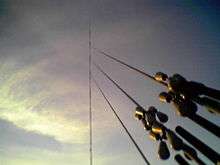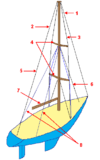Guy-wire
A guy-wire, guy-line, or guy-rope, also known as simply a guy, is a tensioned cable designed to add stability to a free-standing structure. They are used commonly in ship masts, radio masts, wind turbines, utility poles, fire service extension ladders used in church raises and tents. A thin vertical mast supported by guy wires is called a guyed mast. Structures that support antennas are frequently of a lattice construction and are called "towers". One end of the guy is attached to the structure, and the other is anchored to the ground at some distance from the mast or tower base. The tension in the diagonal guy-wire, combined with the compression and buckling strength of the structure, allows the structure to withstand lateral loads such as wind or the weight of cantilevered structures. They are installed radially, usually at equal angles about the structure, in trios and quads. As the tower leans a bit due to the wind force, the increased guy tension is resolved into a compression force in the tower or mast and a lateral force that resists the wind load. For example, antenna masts are often held up by three guy-wires at 120° angles. Structures with predictable lateral loads, such as electrical utility poles, may require only a single guy-wire to offset the lateral pull of the electrical wires, at a spot where the wires change direction.
Conductive guy cables for radio antenna masts may disturb the radiation pattern of the antenna, so their electrical characteristics must be included in the design.
Uses


Sailing
The guys supporting a sailboat mast are called "standing rigging" and in modern boats are stainless steel wire rope. Guys are rigged to the bow and stern, usually as a single guy. Lateral guys attach to "chain plates" port and starboard attached to the hull. Multiple guys are usually installed with spreaders to help keep the mast straight ("in column"). Temporary guys are also used on a sailboat, a fore-guy is a term for a line (rope) attached to and intended to control the free end of a spar. On a modern sloop-rigged sailboat with a symmetric spinnaker, the spinnaker pole is the spar most commonly controlled by one or more guys.
Utility pole guy-wires
Utility poles are buried in the ground and have sufficient strength to stand on their own; guys are only needed on some poles to support unbalanced lateral loads due to the utility wires attached to them or to resist ground movement. Guys are particularly needed on dead-end (anchor) poles, where a long straight section of wire line ends, or angles off in another direction. To protect the public against faults that might allow the cable to become electrified, utility guy cables usually have a ceramic strain insulator ("Johnny ball") inserted near the top, to ensure that any dangerous voltages do not reach the lower end of the wire accessible to the public. The lower end where the cable enters the ground is often encased in a length of yellow plastic reflector to make it more visible, so that people or vehicles do not run into it.
In urban areas where the ground area around the pole is restricted, a variation called a sidewalk guy is often used. In this type the guy line extends diagonally from the top of the pole to a horizontal spar brace extending out from the middle of the pole, and from this it continues vertically to the ground. Thus the bottom part of the guy is vertical and does not obstruct headroom, so a sidewalk can pass between the pole and the guy.
An alternative to guy-wires sometimes used on dead-end poles is a push-brace pole, a second pole set at an angle in the ground which butts diagonally against the side of the vertical pole.
Antenna mast guy-wires
Electromagnetic fields from the antennas complicate the design of guys that support mast antennas. Conductive metal guy-wires whose lengths are near to quarter wavelength multiples of the transmitted frequency can distort the radiation pattern of the antenna. This also applies to guy wires of neighboring masts or metal structures situated nearby. To prevent this, each guy wire is divided by strain insulators into multiple sections, each segment non-resonant at the transmitted wavelength. Cylindrical or egg-shaped porcelain "Johnny ball" insulators (also called "egg insulators") are usually used. Non-conductive guys of Kevlar fiber (Phillystran) or extruded fiberglass rod are frequently used to not disturb the radiation pattern of the antennas. The strength and low stretch properties of Kevlar fiber approaches that of steel. However, Kevlar is very susceptible to ultraviolet degradation so it is enclosed in a UV resistant plastic sheath.
The individual sections of conductive guys can develop large charges of static electricity, especially on very tall masts. The voltage caused by this static electricity can be several times larger than that generated by the transmitter. In order to avoid dangerous and unpredictable discharges, the insulators must be designed to withstand this high voltage, which results at tall masts in over-dimensioned backstage insulators. At each backstage insulator, a lightning arrestor in the form of an arc gap is required for the purpose of over-voltage protection in case of lightning strikes. The insulators and arrestors must be maintained carefully, because an insulator failure can result in a mast collapse. Egg insulators have the porcelain in compression and if it fails, the end loops of the guy wires are still intertwined.
AM radio broadcast towers are often fitted with insulators at the mast base and the RF energy is fed at that point. Some are also insulated at the center for feeding the RF energy at that point. Wire rope guys are frequently used and segmented with insulators at several points. Extensive lightning protection is required for insulated towers.
On antennas for long-wave and VLF, the guys may serve an electrical function, either for capacitive lengthing of the mast or for feeding the mast with the radiation power. In these cases, the guys are fixed without an insulator on the mast, but there is at least one insulator in the guy if necessary. If guys are used for feeding the mast with high frequency power it is often possible to use a grounded mast. The power to the guys is fed via wires running from a tuning unit to the feed point on the guys.
Crane tag lines
When operating a crane, guy wires, known as tag lines, may be connected to unwieldy payloads, allowing ground crew to control rotation and swaying while maintaining a safe distance.
Anchors
In ground-anchored guys, the structure which attaches the guy-wire to the ground is called an anchor.[1] The anchor must be adequate to resist the maximum tensile load of the guy wires; both the dead load of the tension of the wire and the maximum possible live load due to wind. Since the guy wire exerts its force at an angle, the anchor has both vertical and lateral (horizontal) forces on it. The anchor relies on the lateral shear strength of the soil to resist the forces from all of the guys attached to it. Several types of anchor are used:
Dead man anchors
In this type, a hole is excavated and an object with a large surface area is placed in it with the guy wire attached, and the hole is backfilled with earth or concrete.[1] In the historical form of dead man anchor, a log is buried horizontally in a trench with the guy attached perpendicularly to its center. Modern forms are the plate anchor, in which the guy is attached to a rod with an eyelet extending from the center of a steel plate buried diagonally, perpendicular to the angle of the guy. In the concrete anchor, a diagonal rod with an eyelet extending in the guy direction is cemented into a hole filled with steel reinforced concrete. A sufficiently massive concrete block on the surface of the ground can also be used as a dead man.
Screw anchors
This type consists of a rod with wide screw blades on the end and an eyelet on the other for the guy wire.It is screwed deep into the ground, at the same angle as the guy, by a truck-mounted drill machine. These are commonly used as guy anchors for utility poles since they are quick to install with a truck mounted hydraulic powered auger drive.
Expanding anchors
A rod with a pivoted blade on the end is driven into the earth.[1] When the guy wire is attached and tensioned, its force pulls the blade open, "setting" it into the soil. These are often used by the military for rapid mast installations.
Grouted anchors
These are used in both soil and rock.[1] A hole is drilled at the angle of the guy. A steel anchor rod with an eye is inserted, and the hole around it is filled with a liquid grout consisting of concrete and an expansion agent or a structural epoxy. When the grout hardens or expands, the anchor is secure.
Guyed structures
Historically, guyed structures have been some of the tallest man-made structures in the world. There are also many structures which consist of a free standing bottom and a guyed top. These are either partially guyed towers or additionally guyed towers, the latter of which may be used temporarily to support tall buildings during their construction.
See also
| Look up guy-wire in Wiktionary, the free dictionary. |
- Guy (sailing)
- Radio masts and towers
- Soil kite
- Tie rod
- Turnbuckle
- Shackle
- Ferrule
- Jin-pole
- Bracing (aeronautics)#Bracing_wires
